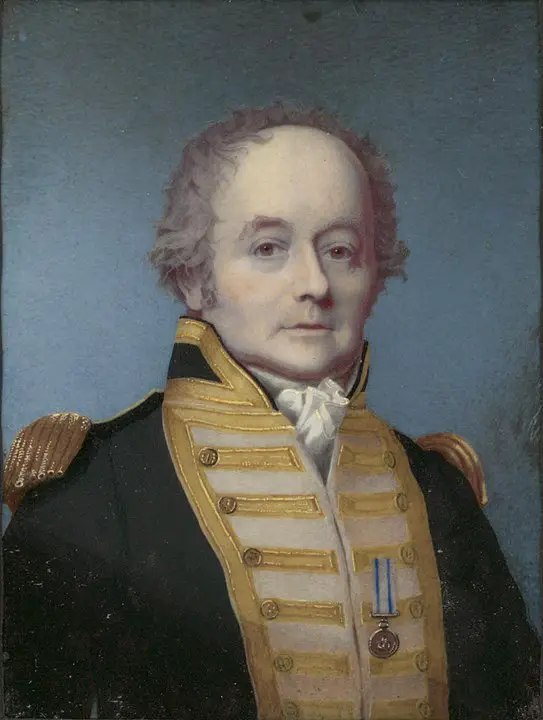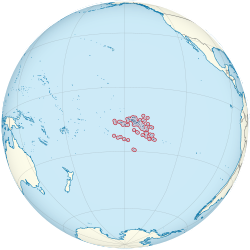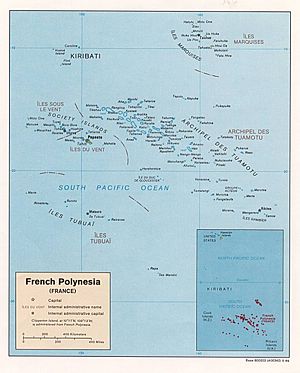French Polynesia
| Polyn√©sie fran√ßaise PŇćrńęnetia FarńĀni French Polynesia |
||||||
|---|---|---|---|---|---|---|
|
||||||
| Motto:¬†"Tahiti Nui MńĀre'are'a" (Tahitian) "Libert√©, √Čgalit√©, Fraternit√©" (French) |
||||||
| Anthem: La Marseillaise |
||||||
| Capital | Papeetńď | |||||
| Largest city | Fa'a'a | |||||
| Official languages | French | |||||
| Ethnic groups  | (in 1988, last ethnic census)[1] 66.5% unmixed Polynesians; 7.1% Polynesians with light European and/or East Asian mixing; 11.9% Europeans (mostly French); 9.3% Demis (mixed European and Polynesian descent); 4.7% East Asians (mostly Chinese) |
|||||
| Demonym | French Polynesian | |||||
| Government | Dependent territory | |||||
|  -  | President of France | Nicolas Sarkozy | ||||
|  -  | President of French Polynesia |
Oscar Temaru |
||||
|  -  | High Commissioner | Richard Didier |
||||
| Overseas collectivity of France | ||||||
|  -  | Protectorate | 1842  | ||||
|  -  | Overseas territory | 1946  | ||||
|  -  | Overseas collectivity | 2004  | ||||
| Area | ||||||
|  -  | Total | 4,167 km² (173rd) 1,609 sq mi  |
||||
|  -  | Water (%) | 12 | ||||
| Population | ||||||
|  -  | Jan. 1, 2010 estimate | 267,000[2] (177th) | ||||
|  -  | Aug. 2007 census | 259,596[3] (177th) | ||||
|  -  | Density | 63/km² (130th) 163.2/sq mi |
||||
| GDP (nominal) | 2009 estimate | |||||
|  -  | Total | US$4.535 billion[4] (not ranked) | ||||
|  -  | Per capita | US$16,857.6[4] (not ranked) | ||||
| Currency | CFP franc (XPF) |
|||||
| Time zone | (UTC-10, ‚ąí9:30, -9) | |||||
| Internet TLD | .pf | |||||
| Calling code | ++689 | |||||
French Polynesia, or as it is known in Tahitian language, Porinetia Farani, is a French "overseas country" in the southern Pacific Ocean. It is made up of several groups of Polynesian islands, the most famous island being Tahiti, in the Society Islands group, also the location of the capital of the territory (Papeete). Tahiti played a role in the late eighteenth century saga of the mutiny on the HMS Bounty. In the late twentieth century, French nuclear testing in the territory sparked international protests. Despite the islands' natural beauty which draw thousands of tourists, economic dependence on France persists as a hurdle to eventual independence.
Geography
French Polynesia is an archipelago located in the South Pacific Ocean, about half way between South America and Australia. It is made up of 118 islands and atolls, the largest and most populated being Tahiti at 400 square miles (1,036 square kilometers), and has a total land area of about 1,610 square miles (4,167 square kilometers).
The island groups are: Austral Islands, Bass Islands, Gambier Islands, the Marquesas Islands, the Society Islands (including Tahiti), and the Tuamotu Archipelago. Aside from Tahiti, major atolls and islands, and island groups in French Polynesia include Bora Bora, Hiva Oa, Huahine, Maiao, Maupiti, Mehetia, Moorea, Nuku Hiva, Raiatea, Tahaa, Tetiaroa, Tubuai, and Tupai. Although not an integral part of its territory, Clipperton Island is administered by French Polynesia.
Makatea in French Polynesia is one of the three great phosphate rock islands in the Pacific Ocean, the others being Banaba Island in Kiribati and Nauru. The terrain is a mixture of low islands with reefs, and rugged high islands, the highest point being Mont Orohena, at 7,352 feet (2,241 meters).
Climate
French Polynesia has a tropical but moderate climate, with an average temperature of 81 degrees Fahrenheit (27 degrees Celsius). There is a warm rainy season from November to April, with rainfall amounts peaking in January (13 to 15 inches or about 330 millimeters) and a cool dry season from May to October (the average rainfall for August is less than two inches, or 40 millimeters). The Marquesas Islands are the driest, and the Tubuai Islands are the wettest.
Natural resources include timber, fish, cobalt, and hydropower. Forests and woodland make up 31 percent of land, one percent is arable land, six percent permanent crops, five percent permanent pastures, and 57 percent is classified as ‚Äúother.‚ÄĚ
French Polynesia is located in an area of high seismic activity. Other natural hazards include occasional cyclonic storms in January.
History

Archaeological evidence suggests that Polynesians from Tonga and Samoa settled the Marquesas Islands around 300 C.E. British explorer Samuel Wallis came upon what is now Tahiti in 1767. French navigator Louis Antoine de Bougainville followed soon after, and Captain James Cook visited in 1769. Cook named Tahiti and called its surrounding islands the Society Islands after his sponsor, Britain’s Royal Society.
Tahiti had a part in the saga of the mutiny on the HMS Bounty. Lieutenant William Bligh and the HMS Bounty reached Tahiti in October 1788 to pick up breadfruit plants for the West Indies, in hope that they would grow well and become a cheap source of food for slaves. Bligh and his crew spent five months in Tahiti, then called ‚ÄúOtaheite.‚ÄĚ The crew lived ashore to care for the 1,015 potted plants and became entranced by the seductive Tahitian culture and women. Many of the crew had themselves tattooed. Acting Lieutenant Fletcher Christian married a Tahitian woman. It has been said that the pleasurable stay in Tahiti was a factor in the subsequent mutiny aboard the Bounty in 1789 that has been made famous by several books and films. The mutiny was led by Fletcher Christian against Bligh, who was then cast adrift in a small open boat with 18 loyal men.
Members of the London Missionary Society, who arrived in 1797, were the first European settlers. France annexed the islands beginning in the 1840s. The islands' status changed again in 1880, when they became a colony of France. The port town of Papeete grew as the main economic, administrative, and religious center in the early twentieth century. In 1942 the island of Bora-Bora became a refueling station for United States forces during the Second World War.
The colony became an overseas territory of France in 1945. In a plebiscite held in 1958, the islands voted for the status of an overseas territory within the French community. In 1966 France began a nuclear testing program on uninhabited islands in the Tuamotu Archipelago. A push for greater autonomy throughout the 1970s and 1980s gave the territorial government more power.
In the early 1990s, Tahiti’s high prices and international anti-nuclear sentiment caused the tourism industry to decline. In September 1995, France stirred up widespread protests by resuming nuclear testing at Fangataufa atoll after a three-year moratorium. The last test was on January 27, 1996. The French government signed, in March 1996, the South Pacific Nuclear-Free Zone Treaty, which banned nuclear testing in the region. Widespread unemployment resulted, and France promised to contribute economic aid to help the territory diversify its economy.
Between 2003 and early 2004, the islands were classed as an overseas collectivity of France. However, in 2004, the islands were granted the new designation of ‚Äúoverseas country,‚ÄĚ which allows an increased amount of autonomy.
Politics
The politics of French Polynesia takes place in a framework of a parliamentary representative democracy. As a French overseas collectivity, the president of French Polynesia is the head of government, and of a pluriform multi-party system. The government exercises executive power. Legislative power is vested in both the government and the 49-member Assembly of French Polynesia. Representatives are elected by universal adult suffrage, and the collectivity is represented in both houses of the French National Assembly. As an overseas territory of France, the French military provides defense and law enforcement.
French Polynesia has five administrative subdivisions: the Society Islands (Windward Islands and the Leeward Islands), the Marquesas Islands, the Austral Islands (including the Bass Islands}, the Tuamotus, and the Gambier Islands.
Economy
Since 1962 when France stationed military personnel in the region, French Polynesia changed from a subsistence economy to one in which a high proportion of the work force was either employed by the military or in the tourism industry. By 2006 French Polynesia had a moderately developed economy, which is dependent on imported goods, tourism, and financial assistance from mainland France. Tourist facilities are well developed on the major islands. Tourism accounts for about one-fourth of Gross Domestic Product (GDP) and is a primary source of hard currency earnings. Also, as the noni fruit from these islands is used increasingly for its medicinal benefits, people have been able to find jobs related to this agricultural industry. The legal tender currency of French Polynesia is the CFP franc.
French Polynesia’s per capita GDP was U.S. $17,500 in 2003. The territory received U.S. $367 million in economic aid in 1997. Agriculture products included coconuts, vanilla, vegetables, fruits, poultry, beef, and dairy products. Additionally, in the mid-1990s, French Polynesia was producing more than 95 percent of the world’s supply of cultured pearls.
Exports totaled U.S. $211 million in 2004. Export commodities included cultured pearls (50 percent), coconut products, mother-of-pearl, vanilla, and shark meat. Export partners are France (45.8 percent), Japan (20.6 percent), Niger (13.2 percent), and the United States (12.4 percent).
Imports totaled U.S. $1.7 billion in 2005. Import commodities included fuels, foodstuffs, and equipment. Import partners are France (51.9 percent), Singapore (14.7 percent), New Zealand (0.5 percent), and the United States (6.5 percent).
While most major roads are paved and well maintained, many secondary roads are not. Traffic is brisk and all types of vehicles and pedestrians jockey for space on narrow streets.
Demographics
Total population at the 2005 census was 270,485 inhabitants, 83 percent of whom are Polynesian, local French six percent, metropolitan French four percent, other Europeans two percent, East Asian (mainly Chinese) five percent. In 2002, 69 percent of the population of French Polynesia lived on the island of Tahiti. The urban area of Papeete, the capital city, had 127,635 inhabitants.
French Polynesia is a Christian territory. Fifty four percent are Protestant, 30 percent Roman Catholic, and 16 percent are listed as ‚Äúother.‚ÄĚ
French and Tahitian are the official languages. Other languages with generally local status are Marquesan, Puka-Pukan, Tuamotuan, Mangarevan, Tubuaian, and Rapan.
Literacy rates are high, as 98 percent aged 14 and over can read and write. France provides education. The University of French Polynesia, a small university of around two thousand students, is located in Faa'a, Tahiti.
Culture
The Christian missionaries tried to wipe out traditional Polynesian culture by leveling temples, destroying carvings, and banning tattoos and heady, erotic dancing. But some traditional ways survived, and in the late twentieth century there was a strong push to rediscover traditional arts.
Renowned French painter Paul Gauguin, who left his family and immigrated to Tahiti in 1891, created many images of traditional Polynesian culture. Disappointed to find that the influence of missionaries and colonization had already changed the islands' way of life, he resolved to re-create it through paintings, woodcarvings, and other artworks. He returned to France briefly, but lived out his years in the Marquesas, dying in 1903.
Traditional musical instruments include pahu and toere drums and the curious nose flute called a vivo. Guitars and ukuleles made their way into Polynesia and the locals developed a unique song style that owes much to country and western music in form but has a distinctive South Pacific island groove. Customary dancing (‚Äútamure‚ÄĚ) has slowly returned, but the art of making tapa (bark paper and cloth), has all but disappeared.
Tattooing is an integral part of the Tahitian culture. The western word ‚Äútattoo‚ÄĚ is taken from the Tahiti word tatau meaning open wound. A tattoo represents a girl's sexual maturity, tribe rank and other social symbols. Tahitian woman would traditionally tattoo their loins and buttocks deep blue. A traditional tattoo is made from a bone containing between three and 20 needles. The needles are then dipped in a pigment made from soot of burnt candlenut mixed with water and oil. The needle is tapped against the skin with a wooden stick causing the skin to be punctured. This practice was banned in 1986 but traditional artists developed a machine constructed from an electric shaver to avoid risk of disease and this practice is in place today. Designs used in the tattoos were often the same as wood- carving, decorated gourds and painted barkcloth. Each tribe would have its own design or body placement of familiar motif, like the Maori tribes' spiral pattern of a tree fern, unique in the Pacific. Tattoos are ancestral and tribespeople do not like to parade their tattoos to outsiders. A higher-ranking individual would have more tattoos that an ordinary tribesman.
Dress standards in French Polynesia are relaxed, even in the classiest restaurants, and beachwear is often just from the waist down. Church is serious and Sunday is the day of worship, fully clothed.
The Polynesian concept of family is broader than in the west‚ÄĒcousins, uncles, and aunts make up the family, known as fetii. The family might also have adopted children, ‚Äúfaaamu, and children are commonly entrusted to relatives or childless women.
French Polynesia has a unique culinary tradition, with old South Pacific cooking methods combining with French, Italian and Chinese cuisine. This appears in restaurants and in the cheap roadside mobile snack bars, les roulottes. Food is cooked in traditional pit ovens common throughout the Pacific. A hole is dug in the ground, stones are placed within it and then a fire is lit to heat the stones. The food, wrapped in banana leaves, is placed on top, and then the hole is filled in again with earth. The baking process takes several hours. In French Polynesia this kind of oven is called an ahimaa, and the feast is called a tamaaraa.
On Tahiti, Papeete is a cosmopolitan city with a strong western influence. Residents enjoy French cuisine. Food, most clothing and other goods are imported, largely from France. The cost of living in Papeete and other urban areas on Tahiti is high, by Pacific Island standards. The lifestyle is much slower on more remote islands, with more subsistence activities.
French national holidays are celebrated. Canoe racing and other water sports are popular. Tahitian music and dances have enthusiastic audiences.
French Polynesia has one of the lowest crime rates within France and its territories. However, petty crime, such as pocket picking and purse snatching, occurs.
Notes
- ‚ÜĎ Alexandrine Brami Celentano, Fronti√®res ethniques et red√©finition du cadre politique √† Tahiti HERM√ąS 32-33 (2002): 367-375. Retrieved January 20, 2012.
- ‚ÜĎ (French) Institut Statistique de Polyn√©sie Fran√ßaise (ISPF). Bilan, principaux indicateurs et estimations de population (Ensemble Polyn√©sie). Retrieved January 20, 2012.
- ‚ÜĎ (French) Institut Statistique de Polyn√©sie Fran√ßaise (ISPF). Population l√©gale au 20 ao√Ľt 2007. Retrieved January 20, 2012.
- ‚ÜĎ 4.0 4.1 UN Data, French Polynesia Country Profile. Retrieved January 20, 2012.
External links
All links retrieved April 11, 2024.
- Jane's Tahiti Home Page: tourist information on French Polynesia
- Presidency of French Polynesia
- University of French Polynesia
| Countries and territories of Oceania | |
| Australia : Australia · Norfolk Island | |
| Melanesia : East Timor · Fiji · Maluku Islands & Western New Guinea (part of Indonesia) · New Caledonia · Papua New Guinea · Solomon Islands · Vanuatu | |
| Micronesia : Guam · Kiribati · Marshall Islands · Northern Mariana Islands · Federated States of Micronesia · Nauru · Palau · Wake Island | |
| Polynesia : American Samoa · Cook Islands · French Polynesia · Hawaii · New Zealand · Niue · Pitcairn Islands · Samoa · Tokelau · Tonga · Tuvalu · Wallis and Futuna | |
Credits
New World Encyclopedia writers and editors rewrote and completed the Wikipedia article in accordance with New World Encyclopedia standards. This article abides by terms of the Creative Commons CC-by-sa 3.0 License (CC-by-sa), which may be used and disseminated with proper attribution. Credit is due under the terms of this license that can reference both the New World Encyclopedia contributors and the selfless volunteer contributors of the Wikimedia Foundation. To cite this article click here for a list of acceptable citing formats.The history of earlier contributions by wikipedians is accessible to researchers here:
The history of this article since it was imported to New World Encyclopedia:
Note: Some restrictions may apply to use of individual images which are separately licensed.



